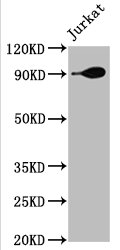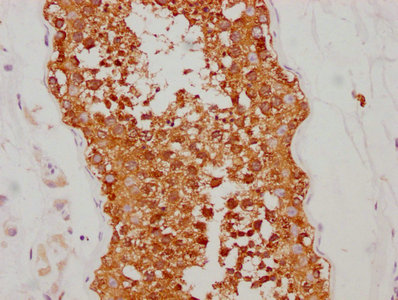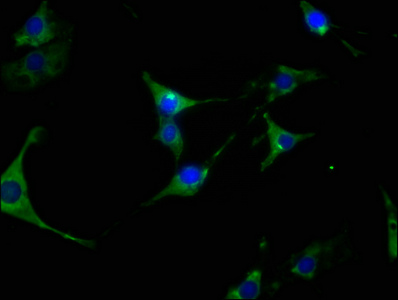
Western Blot Positive WB detected in: Jurkat whole cell lysate All lanes: Hsp90 alpha antibody at 1.9microg/ml Secondary Goat polyclonal to rabbit IgG at 1/50000 dilution Predicted band size: 85, 99 KDa Observed band size: 90 KDa
HSP90AA1 Recombinant Monoclonal Antibody
CSB-RA011087A2HU
ApplicationsImmunoFluorescence, Western Blot, ELISA, ImmunoHistoChemistry
Product group Antibodies
ReactivityHuman
TargetHSP90AA1
Overview
- SupplierCusabio
- Product NameHSP90AA1 Recombinant Monoclonal Antibody
- Delivery Days Customer20
- ApplicationsImmunoFluorescence, Western Blot, ELISA, ImmunoHistoChemistry
- CertificationResearch Use Only
- ClonalityMonoclonal
- Clone ID4D1
- ConjugateUnconjugated
- Gene ID3320
- Target nameHSP90AA1
- Target descriptionheat shock protein 90 alpha family class A member 1
- Target synonymsEL52; epididymis luminal secretory protein 52; epididymis secretory sperm binding protein Li 65p; heat shock 86 kDa; heat shock 90kD protein 1, alpha; heat shock 90kD protein 1, alpha-like 4; heat shock 90kD protein, alpha-like 4; heat shock 90kDa protein 1, alpha; heat shock protein 90kDa alpha (cytosolic), class A member 1; heat shock protein 90kDa alpha family class A member 1; heat shock protein HSP 90-alpha; HEL-S-65p; HSP 86; Hsp103; HSP86; Hsp89; HSP89A; Hsp90; HSP90A; HSP90N; HSPC1; HSPCA; HSPCAL1; HSPCAL4; HSPN; LAP2; LAP-2; lipopolysaccharide-associated protein 2; LPS-associated protein 2; renal carcinoma antigen NY-REN-38
- IsotypeIgG
- Protein IDP07900
- Protein NameHeat shock protein HSP 90-alpha
- Scientific DescriptionMolecular chaperone that promotes the maturation, structural maintenance and proper regulation of specific target proteins involved for instance in cell cycle control and signal transduction. Undergoes a functional cycle that is linked to its ATPase activity which is essential for its chaperone activity. This cycle probably induces conformational changes in the client proteins, thereby causing their activation. Interacts dynamically with various co-chaperones that modulate its substrate recognition, ATPase cycle and chaperone function (PubMed:11274138, PubMed:15577939, PubMed:15937123, PubMed:27353360, PubMed:29127155). Engages with a range of client protein classes via its interaction with various co-chaperone proteins or complexes, that act as adapters, simultaneously able to interact with the specific client and the central chaperone itself (PubMed:29127155). Recruitment of ATP and co-chaperone followed by client protein forms a functional chaperone. After the completion of the chaperoning process, properly folded client protein and co-chaperone leave HSP90 in an ADP-bound partially open conformation and finally, ADP is released from HSP90 which acquires an open conformation for the next cycle (PubMed:27295069, PubMed:26991466). Apart from its chaperone activity, it also plays a role in the regulation of the transcription machinery. HSP90 and its co-chaperones modulate transcription at least at three different levels (PubMed:25973397). In the first place, they alter the steady-state levels of certain transcription factors in response to various physiological cues(PubMed:25973397). Second, they modulate the activity of certain epigenetic modifiers, such as histone deacetylases or DNA methyl transferases, and thereby respond to the change in the environment (PubMed:25973397). Third, they participate in the eviction of histones from the promoter region of certain genes and thereby turn on gene expression (PubMed:25973397). Binds bacterial lipopolysaccharide (LPS) and mediates LPS-induced inflammatory response, including TNF secretion by monocytes (PubMed:11276205). Antagonizes STUB1-mediated inhibition of TGF-beta signaling via inhibition of STUB1-mediated SMAD3 ubiquitination and degradation (PubMed:24613385).
- ReactivityHuman
- Storage Instruction-20°C or -80°C
- UNSPSC12352203


